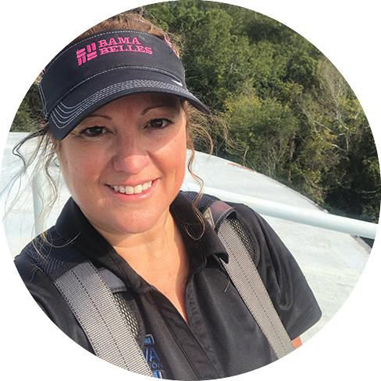Partnership For Safe Water Going Strong At 25
By Joe Cogliano
A quarter-century into its existence, the program started by six prestigious water groups to honor the highest achieving drinking water utilities continues to grow and evolve.
As part of a newer effort to boost distribution system performance, Birmingham Water Works is installing solar-powered mixers in tanks with slow turnover while instituting a more stringent mixing schedule across all its tanks. The goal is to improve water quality throughout the system, especially in rural areas with small populations and distant utilities that purchase water from Birmingham for delivery to their own systems.
Birmingham was already meeting regulatory requirements, but management and operators there were inspired to exceed those benchmarks through its participation in the Partnership for Safe Water (PSW) program.
“It gives you that goal, something to reach for to be even better,” said April Nabors, an engineer with the Birmingham Water Works Board. “What the partnership teaches you to do is assess where you are really at, and to learn through all of that how to continually improve.”
Birmingham Water Works — the largest water utility in Alabama, serving about 650,000 people in a five-county area — has participated in PSW for about two decades. During the early years of its involvement, the board purchased a pilot plant, essentially a semi-trailer that contains a small-scale model of its treatment system, which provided the ability to test the impact of various chemicals on its processes.
This eventually drove widespread changes.
“We had been meeting the numbers we needed to meet for regulatory purposes, but the partnership gave us a reason to push for that next-higher level of water quality,” Nabors said.
As the PSW celebrates its 25th anniversary this year, program officials are gearing up for another quarter-century of providing a boost to water utilities such as Birmingham. Within the past year, PSW began offering online access to a data management platform to streamline reporting, so sending spreadsheets or files is no longer required.
The PSW is an alliance of six organizations, including the American Water Works Association (AWWA), the U.S. EPA, the Association of State Drinking Water Administrators, the Association of Metropolitan Water Agencies, the National Association of Water Companies, and the Water Research Foundation. The effort started with treatment plant optimization, and a distribution system optimization segment was added in 2012.
Both components are designed to provide tools to optimize performance through continuous improvement, with multiple levels of accomplishments in each area, and to be inclusive of occupations across a water organization.

April Nabors, an engineer with the Birmingham Water Works Board, preparing to take a reading from the top of a tank. Birmingham is focusing on tank mixing to improve its water quality.
The process starts with collecting baseline and annual data, then performing a self-assessment to identify limiting factors that allow the creation of an action plan, said Todd Brewer, Senior Manager – Grants, Education & Utility Programs at AWWA. The self-assessment guide offers hundreds of questions spanning multiple topics, including residual maintenance, main repair, and the management of coagulant.
This exercise often shows a variety of issues that might otherwise be overlooked (such as the need for additional sensors to get a better handle on chlorine residual in the system), that operators need better training in data collection, or that a tank maintenance plan is necessary to prevent water-quality issues or structural failures. It also provides an opportunity to gather representatives from across the organization — treatment operators, repair personnel, and laboratory technicians, as well as finance and IT specialists — which leads to discussions that reveal pathways to improvement.
“It’s really a launching pad,” Brewer said. “Bringing multiple parties to the table helps facilitate discussions about current practices and how new practices that save money over the long term can be funded into reality. With tank maintenance, for instance, there might be a better understanding [that] it’s more about asset maintenance than simply about accomplishing beautification projects.”
He points to another example in which an IT department may be storing data — collected from operators, repair personnel, and the lab — that could be a gold mine of actionable information if applied properly. The assessment exercise can bring these possibilities to the forefront.
Success In Colorado
As a young operator, Kevin Linder thought PSW was simply a data collection exercise. Over time, however, he began to understand it was different from other water industry programs that narrowly emphasized data.
“One of the neat things I’ve gotten to do is watch the Partnership for Safe Water actually change the culture in a utility, because it looks at all parts of the operation and not just the numbers leaving the plant,” said Linder, who serves as Advanced Water Treatment Superintendent with Aurora Water in Colorado. “The program does look at that [the numbers], but the real essence is the posture you take every day when you come into work and how you do the things you do.”
Aurora Water, which serves about 400,000 people, is a charter member of PSW, both in the treatment plant optimization segment and distribution system optimization segment. For Linder and his colleagues, PSW helped minimize mistakes commonly made when improvising by driving Aurora Water to develop standard operating procedures that focus on building redundancies and preparing for any contingency that might impact public health.
“Have you identified where you’re not bulletproof? Have you identified where you might need to have an extra chemical pump sitting on a shelf? What if you have a wildfire in your watershed, then you have a torrential downpour? How are you going to respond, because you’re going to have a bunch of mud coming into your plant?” Linder asked.
These days, the planning process at Aurora Water is typically driven by the need for a task for which there is no standard operating procedure. Using the PSW approach, representatives from multiple disciplines — operators, maintenance personnel, instrumentation specialists — are gathered to get a comprehensive understanding of the impact on safety, water quality, compliance, and budget.

Kevin Linder, Advanced Water Treatment Superintendent, Aurora Water
Several years ago, for example, Aurora Water was faced with a blue-green algae bloom in its reservoir. Because of the procedures developed as a direct result of PSW, Linder’s group was prepared to run the biofilter effluent from the conventional treatment trains through the adsorbers on the advanced treatment trains, thereby eliminating a significant number of taste and odor complaints. Instead, it had just a handful of issues. More recently, the PSW framework drove Aurora Water officials to hold COVID discussions to map out how to protect employees and prevent the treatment plant from being compromised.
For Linder, it’s clear that PSW has solidified the long-term health of the utility.
“It’s a good thing for the plant but the best thing for the citizens of Aurora,” he said.
A Flexible Approach
Because it’s often not possible to tackle every improvement prospect at once, AWWA’s Brewer suggests looking at the simplest and lowest-cost action plan items first or at ones that provide the biggest ROI, then roll any savings into the next project.
For example, operators in the field who collect system information on a regular basis, such as chlorine and turbidity levels, have likely been trained on the process by various people, based on their own personal recollections, which can lead to inconsistencies. Utilities can increase the reliability and value of data by documenting operating procedures and providing standardized training. The only investments are in time and effort.
Creating an action plan is also effective for mapping out a long-term investment strategy that carries more weight because it comes from an objective group analysis and not just a narrow perspective that might appear biased.
“So, it’s not just one person fighting for their pet projects; it is a solid justification for expenditures,” Brewer said.
Birmingham’s Nabors said PSW has also been good for making connections with other utilities, which provide a sounding board from across the country to discuss best practices as well as things to avoid in potential new projects.
“What you get from being in contact with people who are like-minded, who are working on the same types of goals, is invaluable,” she said.
Both segments of the PSW — treatment plant optimization and distribution system optimization — are available to municipal and privately managed water utilities for an annual fee of $50 to $3,600, depending on the size of the service area. For more information, visit https://www.awwa.org/Resources-Tools/Programs/Partnership-for-Safe-Water. The optimization segment has about 300 member utilities that represent nearly 600 plants, and the distribution system segment spans more than 150 utilities. Most of those members are in the U.S., and, when combined, those systems serve approximately 120 million customers.
“We’ve tried to align data collection and reporting with compliance requirements, so it won’t be onerous,” Brewer said. “But it does take some time to complete. If you can find the time, it is worth the effort and helps establish a culture of excellence.”
Through a separate alliance, AWWA is also involved in building a similar clean water effort for wastewater treatment.
About The Author
 Joe Cogliano is a writer for Water Online, covering issues that impact the water and wastewater industry. Joe spent nearly 15 years covering business news before serving as a Department of Defense contractor, where he supported marketing and communications for an Air Force small business research program. Joe earned a journalism degree from Ohio University.
Joe Cogliano is a writer for Water Online, covering issues that impact the water and wastewater industry. Joe spent nearly 15 years covering business news before serving as a Department of Defense contractor, where he supported marketing and communications for an Air Force small business research program. Joe earned a journalism degree from Ohio University.
